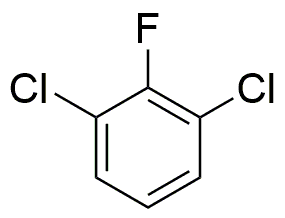2,6-Dichlorofluorobenzene is widely utilized in research focused on:
- Organic Synthesis: This compound serves as an important intermediate in the synthesis of various organic molecules, allowing chemists to create complex structures efficiently.
- Pesticide Formulation: It is used in the development of agrochemicals, particularly in formulating pesticides that target specific pests while minimizing environmental impact.
- Pharmaceutical Development: The compound plays a role in the pharmaceutical industry, where it is involved in the synthesis of active pharmaceutical ingredients (APIs) that can enhance drug efficacy.
- Material Science: It is utilized in the production of specialty materials, including polymers and resins, which are essential for creating durable and high-performance products.
- Research and Development: In academic and industrial labs, it is a valuable reagent for studying reaction mechanisms and developing new chemical processes, contributing to innovation in chemistry.
General Information
Properties
Safety and Regulations
Applications
2,6-Dichlorofluorobenzene is widely utilized in research focused on:
- Organic Synthesis: This compound serves as an important intermediate in the synthesis of various organic molecules, allowing chemists to create complex structures efficiently.
- Pesticide Formulation: It is used in the development of agrochemicals, particularly in formulating pesticides that target specific pests while minimizing environmental impact.
- Pharmaceutical Development: The compound plays a role in the pharmaceutical industry, where it is involved in the synthesis of active pharmaceutical ingredients (APIs) that can enhance drug efficacy.
- Material Science: It is utilized in the production of specialty materials, including polymers and resins, which are essential for creating durable and high-performance products.
- Research and Development: In academic and industrial labs, it is a valuable reagent for studying reaction mechanisms and developing new chemical processes, contributing to innovation in chemistry.
Documents
Safety Data Sheets (SDS)
The SDS provides comprehensive safety information on handling, storage, and disposal of the product.
Product Specification (PS)
The PS provides a comprehensive breakdown of the product’s properties, including chemical composition, physical state, purity, and storage requirements. It also details acceptable quality ranges and the product's intended applications.
Certificates of Analysis (COA)
Search for Certificates of Analysis (COA) by entering the products Lot Number. Lot and Batch Numbers can be found on a product’s label following the words ‘Lot’ or ‘Batch’.
Numéro de catalogue
Numéro de lot/série
Certificates Of Origin (COO)
This COO confirms the country where the product was manufactured, and also details the materials and components used in it and whether it is derived from natural, synthetic, or other specific sources. This certificate may be required for customs, trade, and regulatory compliance.
Numéro de catalogue
Numéro de lot/série
Safety Data Sheets (SDS)
The SDS provides comprehensive safety information on handling, storage, and disposal of the product.
DownloadProduct Specification (PS)
The PS provides a comprehensive breakdown of the product’s properties, including chemical composition, physical state, purity, and storage requirements. It also details acceptable quality ranges and the product's intended applications.
DownloadCertificates of Analysis (COA)
Search for Certificates of Analysis (COA) by entering the products Lot Number. Lot and Batch Numbers can be found on a product’s label following the words ‘Lot’ or ‘Batch’.
Numéro de catalogue
Numéro de lot/série
Certificates Of Origin (COO)
This COO confirms the country where the product was manufactured, and also details the materials and components used in it and whether it is derived from natural, synthetic, or other specific sources. This certificate may be required for customs, trade, and regulatory compliance.


